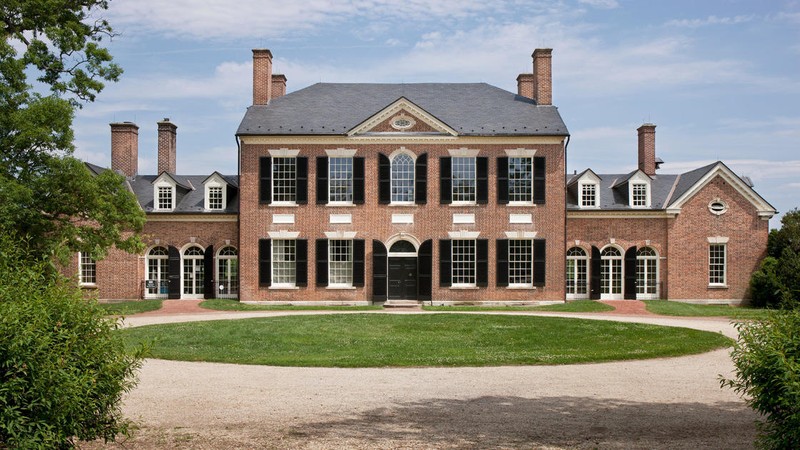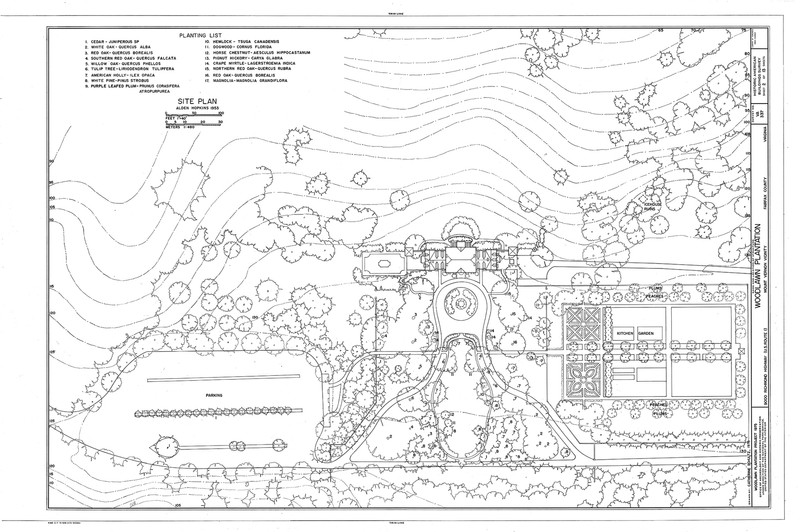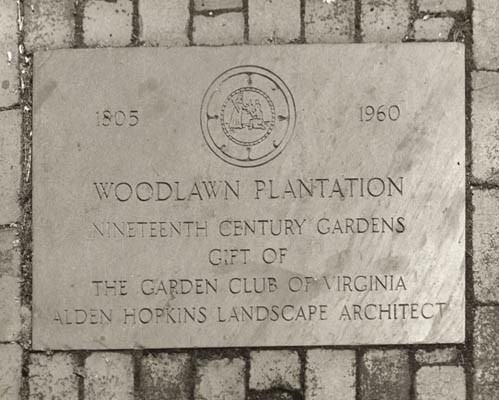Woodlawn Plantation Estate
Introduction
Text-to-speech Audio
Images
The Woodlawn Estate

The Woodlawn Plantation Layout

Woodlawn Plantation Garden Club Plaque

Backstory and Context
Text-to-speech Audio
The Woodlawn plantation house is a brick structure that blends the Georgian and Federal styles. Dr. William Thornton, a former physcian, was the architect for the property, which was completed in 1805. The Lewises hosted guests and officials from the region and beyond, including the Marquis de Lafayette. The estate included outbuildings in addition to the main manor house, including a dairy, two necessaries, a bower, and quarters for enslaved workers, which would have been close to agricultural fields. The plantation produced wheat, corn, and some tobacco, but was never successful.
At the time of George Washington’s death in 1799, the Mount Vernon estate would be comprised of as nearly as 317 enslaved individuals. While 123 of those slaves were owned by George Washington himself, another 153 individuals had been inherited by Martha Washington. By law, the Washington’s could not emancipate dower or inherited enslaved persons, since they were previously owned by her late husband, Daniel Parke Custis; therefore upon Martha’s death they were divided among her grandchildren.
The 1810 Census notes that 74 enslaved persons lived on the Woodlawn plantation. This number increased over time; Eleanor Custis Lewis and her family were supported by at least 90 enslaved people of African descent.
After Major Lewis’ death in 1839, the family left the Woodlawn Estate where it sat abandoned for many years. Eventually, the property was sold “to Troth-Gillingham, a ship building company based in NJ, owned by Quakers determined to prove to southerners that one could run a successful business and farm without using slave labor.”1 The new Quaker owners established the estate as a “free-labor colony” and offered many opportunities to former enslaved peoples, like schooling and farming.
Eleanor Custis Lewis moved in with her son Lorenzo after the death of her husband Lawrence in 1839. Some enslaved workers and free white people, most likely an overseer family, remained at the Woodlawn plantation. About ten years later, Lorenzo Lewis and his family sold the estate to Quaker settlers for a lumber company and the establishment of small farms to be sold both to free African-Americans and white settlers. Thus the property which had once held nearly a hundred people in bondage passed into an abolitionist community. The plantation manor served as the Quakers' first meeting house.
In 1850, northern Baptist John Mason and his wife Rachel purchased some property from Woodlawn from the Quakers. This purchase included the manor house, and the Masons moved into it. The Quakers constructed a new meetinghouse on their property and the Masons established a Baptist church. With both the Quaker and the Baptist family on the Woodlawn Estate, it became “the nucleus of two abolitionist religious communities.”1
The estate passed through the hands of several owners through the following years. Upon restoration, the Woodlawn Plantation Estate became open to the public as a museum on May 9th, 1952. The Woodlawn Estate has also become synonymous with the Frank Lloyd Wright property, Pope-Leighey House, which was moved onto the property in 1964 upon threat of demolition due to highway expansion.
The plantation is part of the Woodlawn Cultural Landscape Historic District, on the National Register of Historic Places. The district includes several properties.
Sources
1.Fairfax County VA. Historical Landmarks - Woodlawn Plantation, Fairfax County Virginia. Accessed November 6th 2019. https://www.fairfaxcounty.gov/planning-development/historic/historic-landmarks/woodlawn-plantation.
2.National Trust for Historic Preservation. Woodlawn, National Trust for Historic Preservation. Accessed November 6th 2019. https://savingplaces.org/places/woodlawn#.XcODP3dFyUl.
3.10 Facts About Washington & Slavery, George Washington's Mount Vernon. Accessed November 6th 2019. https://www.mountvernon.org/george-washington/slavery/ten-facts-about-washington-slavery/.
4.Woodlawn Plantation, Virginia Museum of History & Culture . Accessed November 6th 2019. https://www.virginiahistory.org/collections-and-resources/garden-club-virginia/plantations/woodlawn-plantation.
https://savingplaces.org/places/woodlawn
http://www.savingslavehouses.org/va-337_dwg_site02_key/
https://www.virginiahistory.org/collections-and-resources/garden-club-virginia/plantations/woodlawn-plantation
